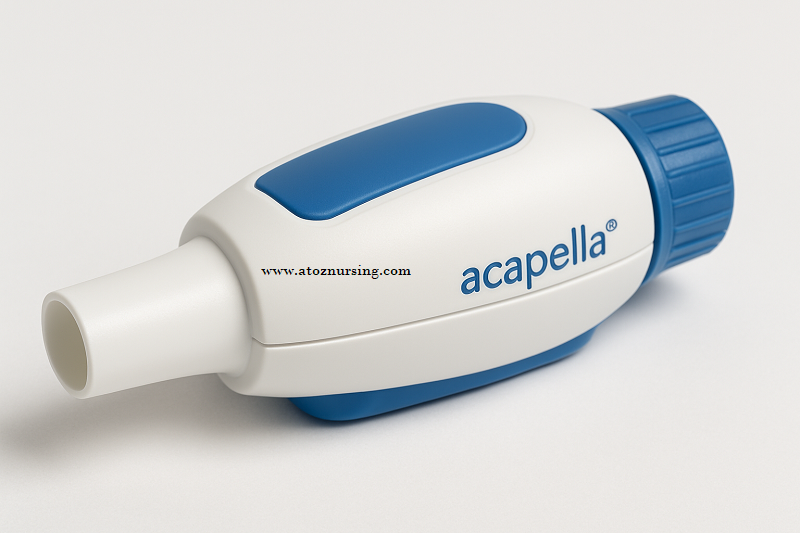The Acapella Oscillatory PEP Device
Introduction to The Acapella Oscillatory PEP Device
The Acapella is an oscillatory positive expiratory pressure (PEP) device designed to provide oscillation to the airways.
This assists in loosening secretions and moving them centrally to make expulsion easier.
It is commonly used to manage respiratory conditions that involve excess mucus production.
How Does the Acapella Device Work?
The Acapella device combines the benefits of both PEP therapy and airway oscillation.
It utilises a unique mechanism that creates oscillatory vibrations which help mobilise mucus, making it easier to clear airways and improve overall breathing efficiency.
Benefits of Using the Acapella Device
The primary advantage of using the Acapella device is its ability to manage secretions effectively.
This can be particularly beneficial for individuals with chronic respiratory conditions such as COPD, bronchiectasis, and cystic fibrosis.
By loosening secretions, the device helps keep the airways clear, thus reducing the risk of infections and improving respiratory function.
Operation and Maintenance
| Step | Description |
|---|---|
| Setup | Connect the device to a mouthpiece or a face mask. |
| Usage | Breathe in deeply and exhale through the device for several breaths, allowing oscillations to mobilise mucus. |
| Cleaning | Disassemble the device and clean all parts with warm, soapy water. Rinse thoroughly and let dry. |
Step-by-Step Nursing Guide for Acapella Setup and Patient Positioning
As a nurse, setting up the Acapella Oscillatory PEP Device and positioning the patient correctly are essential for effective airway clearance therapy. This helps mobilise secretions while ensuring patient safety and comfort. The process involves preparation, device adjustment, and tailored positioning based on the patient’s condition.
Always assess the patient’s respiratory status, ability to follow instructions, and any contraindications (e.g., untreated pneumothorax or recent surgery) before proceeding.
Below are the detailed steps, drawing from clinical guidelines.
Device Setup Steps
Wash hands and gather supplies: Begin by washing your hands with soap and water or using antibacterial gel to prevent infection.
Ensure the Acapella device (e.g., DM blue for low flow or DH green for high flow) is clean and ready; if not, disassemble and clean the mouthpiece and body with liquid dish detergent, rinse, and air dry.
Inspect and assemble the device: Check that all parts are intact and dry. For models like Acapella choice, hold it horizontally and ensure it’s assembled properly.
If combining with aerosol delivery, attach a nebuliser to the end opposite the mouthpiece.
Adjust the resistance dial:
Set the dial on the end opposite the mouthpiece to match the patient’s expiratory flow needs.
Rotate toward “+” for more resistance or “-” for less, based on provider instructions or patient tolerance (e.g., start at “1” for less resistance and increase to “5” as needed). Test for vibrations by having the patient exhale briefly.
Prepare for use: If prescribed, administer short-acting bronchodilators or nebulised medications 15 minutes before enhance airway preparation.
Patient Positioning Guidelines
Positioning optimises secretion drainage and breathing efficiency.
The Acapella is versatile and not strictly position-dependent, but avoid flat supine positions to ease sputum clearance and huffing/coughing. Instruct the patient to relax their stomach muscles and maintain good posture throughout.
Assess and select position: Evaluate the patient’s mobility, comfort, and specific needs (e.g., postural drainage for targeted lung areas).
Common options include upright sitting for most sessions or gravity-assisted positions if advised by a physiotherapist.
Position the patient:
Preferred: Upright seated:
Have the patient sit in a supportive chair with a neutral lumbar spine, shoulders relaxed, and elbows resting on a table. This enhances diaphragm function and minimises strain.
Alternative:
Side-lying or semi-reclined:
If upright sitting isn’t feasible, position the patient lying on their side (e.g., for gravity-assisted drainage) or in a semi-upright crooked position. Alternate sides as needed.
Postural drainage variations:
For specific lobe clearance, use positions like lying flat on the back, on one side, or alternating sides, but only if recommended by the healthcare provider.
Ensure the device can be held horizontally or even upside down, as it still functions effectively.
Instruct on body mechanics: Remind the patient to keep cheeks firm during exhalation to maximise chest vibrations, avoid shoulder shrugging, and breathe with tummy movement for relaxation.
Monitoring During Setup and Positioning
While setting up and positioning, monitor vital signs (e.g., oxygen saturation, respiratory rate) and watch for signs of fatigue or dizziness.
If issues arise, pause and adjust. Sessions typically last 15-30 minutes, 2-4 times daily,
with cycles of deep breaths, holds, exhalations, huffs, and coughs. Educate the patient on self-use to promote independence, and document the setup, positioning, and outcomes in the care plan.
This structured approach ensures safe, effective therapy. If the patient experiences discomfort, consult the provider for modifications.
For more details, Nursing Care
The Acapella Oscillatory PEP Device Video Tutorial

